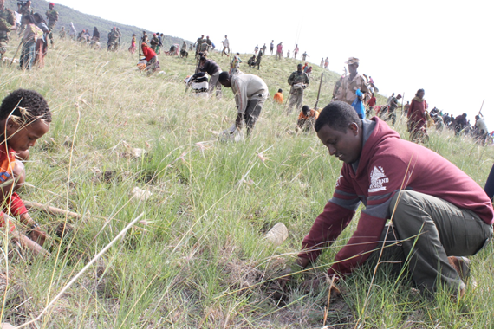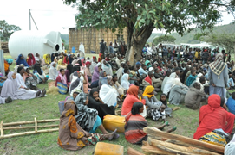Integrated Land use and Community Development: a pilot project in the CRV.
The HoAREC&N-AAU recently, in collaboration with Arsinegele Nature Conservation Environment Development Association( ANCEDA), developed the project -” Integrated landuse and community development pilot project in the CRV “ mainly in the Shashemene and Shalla weredas of the West Arsi Zone, Oromia regional State. One of the key catchments in the project area, the Jama-Urji Mountain raising 2,175 m.a.s.l run into the downstream plain, fragmented with different land use types. The area experienced heavy flooding that eroded the land forming large gullies During heavy rain, the flooding inundates the downstream, draining into the nearby Lake Hawassa aggravating siltation. Degradation on these Mountains gradually impoverished the ecosystem and the biodiversity upon which multitudes of livelong organisms depend on.
The local residents whose life founded primarily on small scale agriculture and livestock keeping have been affected due to drought, and poor land productivity. Consequently, sever poverty, growing population, joblessness etc could amplify social instability and migration, calling for concerted efforts to bring forth sustainable solution before it is too late.
Conserving the Jama-Urji Mountan landscape was one of the strategic option to address the intertwined problems in the landscape. It is upon this premises that the project was developed as part of the CRV landscape interventions financed by Sida (Swedish International Development Agency). The pilot project aimed to benefit about 1831HHs in the project area and indirectly the 14, 583 HHs in the wider communities in the surrounding areas .

Impacts (Contribute to):
Environmental benefits: it drastically reduces the rate of deforestation, soil erosion and flooding and help remove dangerous greenhouse gases from the atmosphere thus contributing to reduce the climate change impacts. It also provides ecosystem services, provisioning, regulating, cultural and supporting services.

Economic prosperity: it generates incomes for local community organized as forest cooperatives by generating carbon revenue and as well as increase productivity and improved food quality. It also presents an opportunity for equitable, and community-based development.

Promote social well-being: it create social and cultural benefits such as recreation, traditional resource uses and spirituality. It also reduces the physical and health burden on girls and women due to fuel collection; this increases learning opportunities for girls and opportunities for productive and social application.
